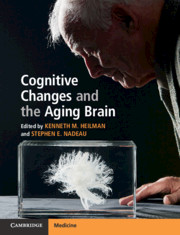Book contents
- Cognitive Changes and the Aging Brain
- Cognitive Changes and the Aging Brain
- Copyright page
- Dedication
- Contents
- Contributors
- Chapter 1 Introduction
- Chapter 2 Anatomic and Histological Changes of the Aging Brain
- Chapter 3 Cellular and Molecular Mechanisms for Age-Related Cognitive Decline
- Chapter 4 Neuroimaging of the Aging Brain
- Chapter 5 Changes in Visuospatial, Visuoperceptual, and Navigational Ability in Aging
- Chapter 6 Chemosensory Function during Neurologically Healthy Aging
- Chapter 7 Memory Changes in the Aging Brain
- Chapter 8 Aging-Related Alterations in Language
- Chapter 9 Changes in Emotions and Mood with Aging
- Chapter 10 Aging and Attention
- Chapter 11 Changes in Motor Programming with Aging
- Chapter 12 Alterations in Executive Functions with Aging
- Chapter 13 Brain Aging and Creativity
- Chapter 14 Attractor Network Dynamics, Transmitters, and Memory and Cognitive Changes in Aging
- Chapter 15 Mechanisms of Aging-Related Cognitive Decline
- Chapter 16 The Influence of Physical Exercise on Cognitive Aging
- Chapter 17 Pharmacological Cosmetic Neurology
- Chapter 18 Cognitive Rehabilitation in Healthy Aging
- Chapter 19 Preventing Cognitive Decline and Dementia
- Index
- References
Chapter 4 - Neuroimaging of the Aging Brain
Published online by Cambridge University Press: 30 November 2019
- Cognitive Changes and the Aging Brain
- Cognitive Changes and the Aging Brain
- Copyright page
- Dedication
- Contents
- Contributors
- Chapter 1 Introduction
- Chapter 2 Anatomic and Histological Changes of the Aging Brain
- Chapter 3 Cellular and Molecular Mechanisms for Age-Related Cognitive Decline
- Chapter 4 Neuroimaging of the Aging Brain
- Chapter 5 Changes in Visuospatial, Visuoperceptual, and Navigational Ability in Aging
- Chapter 6 Chemosensory Function during Neurologically Healthy Aging
- Chapter 7 Memory Changes in the Aging Brain
- Chapter 8 Aging-Related Alterations in Language
- Chapter 9 Changes in Emotions and Mood with Aging
- Chapter 10 Aging and Attention
- Chapter 11 Changes in Motor Programming with Aging
- Chapter 12 Alterations in Executive Functions with Aging
- Chapter 13 Brain Aging and Creativity
- Chapter 14 Attractor Network Dynamics, Transmitters, and Memory and Cognitive Changes in Aging
- Chapter 15 Mechanisms of Aging-Related Cognitive Decline
- Chapter 16 The Influence of Physical Exercise on Cognitive Aging
- Chapter 17 Pharmacological Cosmetic Neurology
- Chapter 18 Cognitive Rehabilitation in Healthy Aging
- Chapter 19 Preventing Cognitive Decline and Dementia
- Index
- References
Summary
Neuroimaging visualizes and quantifies age-related changes in brain structure, function, cerebral blood flow, and cerebral metabolic health. MRI studies show reductions in both overall and regional brain volumes, but to a lesser extent than in Alzheimer’s disease. Those aging non-pathologically tend to have relative preservation of mesial temporal and enthorhinal brain areas. White matter changes are also common as shown by hyperintensities on fluid attenuated inversion recovery and other T2 MRI images, presumably as a result of co-morbities that increasingly occur with age. Diffusion tensor imaging shows reductions in white matter integrity, including white matter fiber counts and overall white matter volume, beginning in mid- to late life. The neural response during both rest and task performance also shows reduced activation of core task-related networks but expansion to include other region activation. Reduced cerebral blood volume and flow also occur, likely reflecting alterations in hemodynamic function due to cerebrovascular and cardiovascular changes. Cerebral metabolic changes on MR spectroscopy occur with reduced concentrations of GABA and other neurotransmitters, as well as markers of neuronal integrity. Myoinositol, a marker of glial activation, may be elevated, indicating neuroinflammation, though this effect is likely not ubiquitous in successful aging.
Keywords
- Type
- Chapter
- Information
- Cognitive Changes and the Aging Brain , pp. 28 - 53Publisher: Cambridge University PressPrint publication year: 2019
References
- 1
- Cited by

